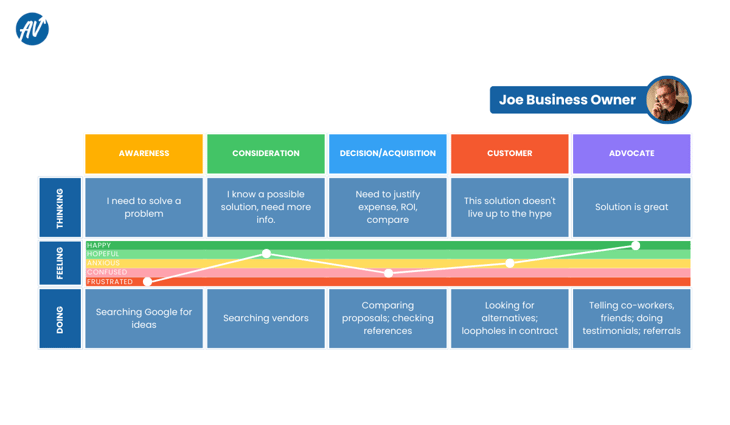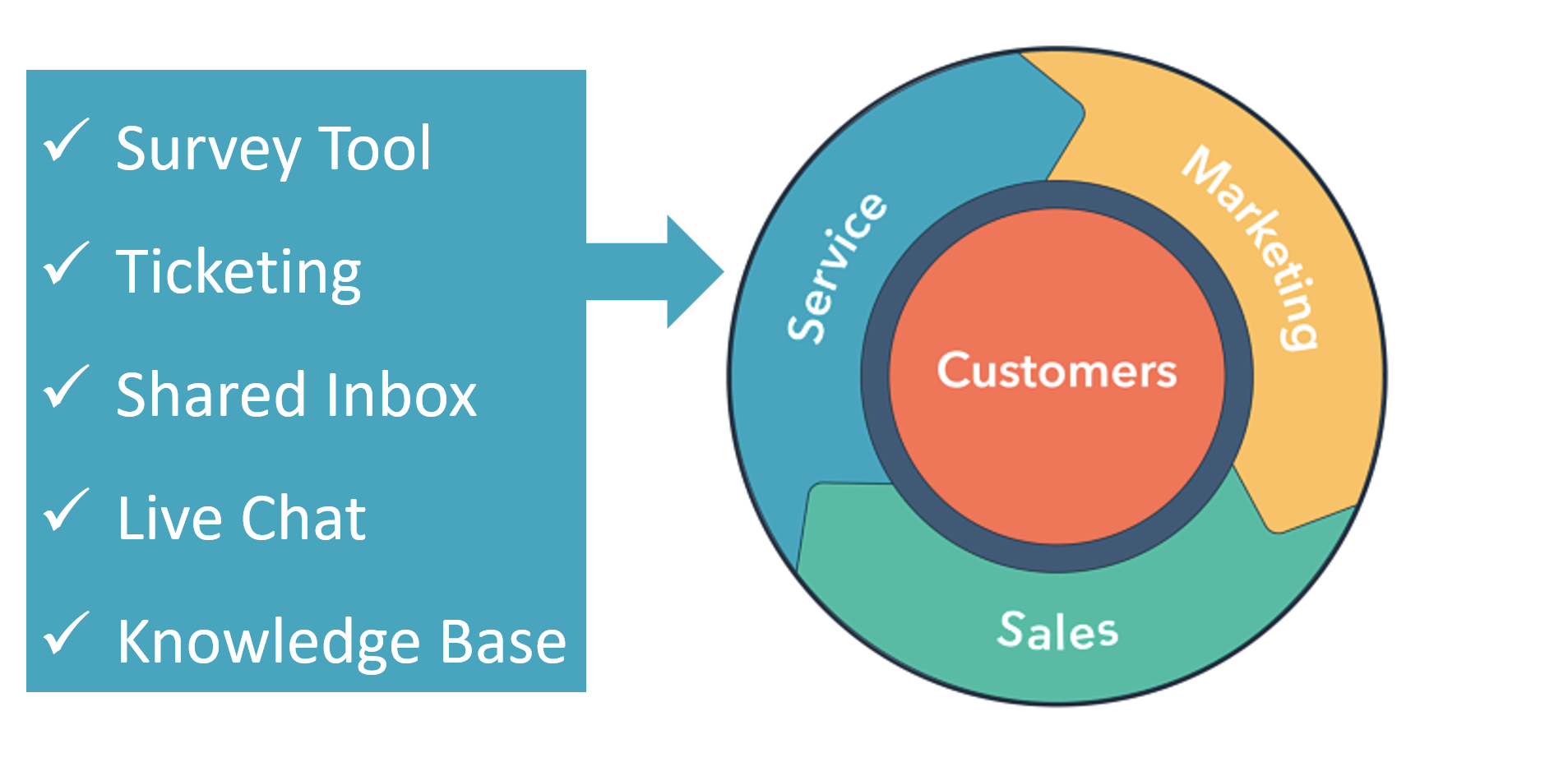The modern buyer experience is often confusing and frustrating for many customers. There are lots of ways that consumers make purchasing decisions. Business marketers need to understand how their products get promoted and consumed in the complex B2B marketplace.
Creating a Customer Journey Map is a beneficial process you can take to understand your customer buying process. It will help you create marketing content for each step of the journey. Customer Journey Maps also identify gaps in your marketing, sales, and customer experience process.
What is a Customer Journey Map?
“A customer journey map is a diagram (or several diagrams) that depict the stages customers go through when interacting with a company, from buying products online to access customer service on the phone to airing grievances on social media.”
Erica Mixon, Tech Target
The Customer Journey Map illustrates how customers act during the buying process so that marketers can understand customer needs. The buyer persona is the focus of each journey map. If you have two or three buyer personas, then you will need an equal number of customer journey maps. Unlike the famous sales funnel, the journey map includes presale and post-sale activities to provide a 360° view of the customer relationship with your business. The map also helps you understand how customers can engage with your brand and the entry points they used to enter the sales process.
Benefits of Mapping Your Customer Journey Experience
The Customer Journey Map is a tool for your entire organization. It provides many benefits that your senior leadership team will use to improve sales and retain more customers.
Identify effective marketing strategies
Every buyer interacts with your brand in different ways. Some buyers may learn about your business through personal relationships, others through direct sales outreach, while other buyers may learn about your brand through social media or digital marketing campaigns.
Find gaps in the sales process
The Customer Journey Map helps marketers understand and align their inbound campaigns to the sales process. By working together to develop the map, sales, and marketing team members will better understand the processes that work. It will also expose the reasons marketing leads aren’t converting into closed sales opportunities.
Improve the customer service experience
The customer service experience is a critical stage in the sales process if you want to keep your customers and convert them into advocates for your brand. A lot can go wrong once a sale is closed and it’s important for the marketing and sales team to understand how to communicate with customers and focus on retaining their business for many years to come. Subscription-based businesses rely on renewals to generate ongoing revenue. The Customer Journey Map can help highlight points when customer communications are sent to renew licenses or upsell to upgraded levels of service.
Three Stages of the Customer Journey
Marketing Stage
Awareness - The early-stage time when buyers are beginning their search for new solutions. Brand awareness advertising, content marketing, and social media campaigns are all entry points into the sales process.
Contact points: Ad click, social engagement, Google search click, offline activity (events, networking, inbound phone calls).
Consideration - This is the stage where buyers are learning more about your products and services. This is the first time you introduce features, benefits, and product options. Content focuses on customer testimonials, reviews, and analyst reports.
Decision - This stage often overlaps with the sales process. This is the point where buyers ask about price, return-on-investment, and references. For eCommerce companies, this is where the buyer interacts with your website and enters the buying process.
Sales Stage
Engage - This is the critical part of the process where buyers reach out to sales via inbound calls, website interactions, social media channels, and live chat.
Demonstrate - Your sales team plays a critical role in demonstrating your product’s key features and benefits. They often do this via an in-person or virtual meeting. For online sales, videos, and interactive presentations are often used to convey how the product or service works.
Close - The part of the sales process where deals are made or lost. Proposals, contracts, statements of work, and legal agreements are all part of the closing process.
Customer Service Stage
Onboarding - When your company sets up your customer accounts, builds out processes, integrations (software), installs, and customizes the product for your customers.
Training - User training is often a critical part of the process to ensure the customer fully uses your products.
Customer support - This stage focuses on help desk services that answer user questions, solve problems, and troubleshoot issues. Customer service delivers these services by phone, online chats, email, and in-person visits.
Upsells, Cross-Sells, and Renewals - Customer account managers are often responsible for customer relationships and maintaining strong communications. Email and SMS communications are often used to convey new offers and upgrades. Renewal communications campaigns are important to keep your customers when their contract terms expire.
Advocate - Happy customers are often glad to promote your business through case studies and videos, provide references, and refer business to your company.
Understanding the Customer
For each stage of the Customer Journey Map, your team must identify the actions the buyer takes during that step. Don’t make the mistake of assuming you know these activities. Instead, interview customers, salespeople, and customer service representatives to understand what your buyers are thinking, feeling, and doing. Many times, marketers make assumptions based on only one or two of the buyer's thoughts and actions.
There are certain parts of the buyer journey where your actions slow down or speed up the journey. These are called points of force and friction and it’s important to identify these points within the customer journey map. Delivery issues, management approvals, or internal process issues might cause points of friction. Points of force may occur when you release new products, launch ad campaigns launched, or announce customer promotions.
The Steps to Creating a Customer Journey Map
- Select a Buyer Persona
- Identify the Stages of Your Customer Journey
- Identify the customer activities
- Create the Map
- Review and edit the map with internal teams
- Repeat for the next persona
- Create advertising, content marketing, sales enablement, and customer communications plans
Sample Customer Journey Map 
How to Implement the Customer Journey Mapping Process
Implementing a cross-functional process may be difficult in your organization. A marketing team can lead the mapping process, but if resources are scarce, then it might make sense to engage a third-party agency or consultant to facilitate the customer journey mapping process. Reach out to your existing creative or marketing automation partners who know your marketing, sales, and service process. Many HubSpot agencies provide customer journey mapping services.
About InboundAV
InboundAV is a full-service business development agency and HubSpot Platinum Partner. We help growing businesses develop game-changing strategies and the automated processes needed to help you scale. As a HubSpot partner, we provide a full range of services to support your operations team, including custom integrations, automated workflows, onboarding, training, and ongoing support services. Contact InboundAV to schedule a free HubSpot consultation.


.png)




